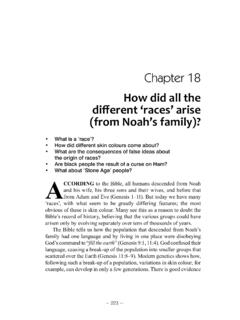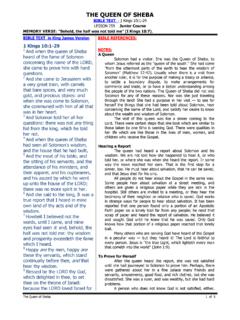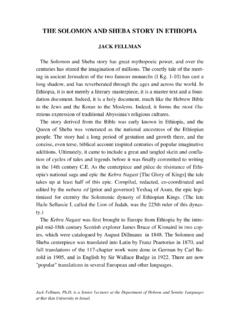Transcription of The Queen of Sheba and the Ethiopian problem - Creation
1 55|| JOURNAL OF Creation 27(2) 2013 VIEWPOINTThe Queen of Sheba and the Ethiopian problem Patrick ClarkeA study of ancient literature, cartography, and the Bible Old Testament narrative shows that the peoples of the Ancient Near East (ANE) viewed their world very differently from our 21st-century eyes. The thiopia (Ethiopia) described by many Greek and Roman writers, and relied upon by a number of chronological revisionists, bears no resemblance to the modern State of Ethiopia, its location, or extent. The idea that the biblical Queen of Sheba ruled ancient Egypt and a land equating to modern Ethiopia is based on a faulty understanding of the Greco-Roman quarter of a century ago, creationist Dr Charles V.
2 Taylor made this observation: I hold no brief for Velikovsky s theology, or lack of it, but one must admit that his chronologies have never seriously been disproved, but rather slandered and libelled without proper examination. 1 What was true 25 years ago is no longer the case today Taylor s observation was justified back then, but now a new generation of scholars is emerging who, while often not holding any brief for conventional chronologies, are challenging Velikovsky s chronology and theology using multi-disciplinary skills. When I read Velikovsky s Ages in Chaos I was surprised by the manner in which he took other people s statements out of their original context, and blended them into novel arguments for chronological revision of the ANE (note that I support the need for revision, but this needs to be on a sound footing).
3 Some of these contextomies were discussed in my 2010 paper Why Pharaoh Hatshepsut is not to be equated to the Queen of Sheba (hereafter PHQS).2 The central argument of David Austin s 2012 Viewpoint in this Journal, The Queen of the South is the Queen of Egypt 3 (hereafter QSQE) is that the Queen of Sheba was a Queen of both Egypt and Ethiopia. QSQE bases its biblical proof that the Queen of the South refers to a Queen of Ethiopia on a very small part of the Book of Daniel (11:5, 6, 8 11). This is supplemented with comments from three authors Young,4 Calvin,5 and Mauro6 all from works that discussed the end-times Great Tribulation.
4 The core of the QSQE case is this: if Jesus Queen of the South can be linked to Daniel s King of the North (Syria), and King of the South (Egypt), the Queen of the South must be Egyptian also. It all sounds very straightforward, but as we shall see, linking this idea to the notion of this Queen being monarch of Egypt and of a land or region called thiopia by Greek and Roman historians is not as simple as followers of Velikovsky s revision would have us in the QSQE abstractBefore discussing the Ethiopian question in depth, let us examine the QSQE abstract. It begins with a bold assertion: Biblical and geographical arguments support the idea that The Queen of Sheba .
5 Was The Queen of Egypt, not Arabia. Nowhere in the Bible is mention made of any Queen of Egypt this was covered in my original paper, The region today called Arabia was not known by that name in the period in question. The first written record of the name Arabia seems to be Her odotus The Histories, Book III, c. 430 BC: There is a great river in Arabia, called the Corys, which empties itself into the Erythraean Sea. 8 The name Arabia comes from the Old Persian where it is pronounced Arab ya , and does not appear in the crucial period of Solomon in the 10th century BC timeframe required by the QSQE proposal. QSQE s reliance on a modern map (figure 1) to explain things, with its modern names and geo-political boundaries, is pointless the modern and ancient worlds were, and are, quite different next sentence of the abstract reads: The reigns of the Queen of Sheba and Queen Hatshepsut were also contemporaneous.
6 The reigns of Queen Elizabeth II of Great Britain (1953 present) and that of Queen Juliana of the Netherlands (1948 1980) were also contemporaneous. No-one would claim that they are one and the same monarch as a result of any contemporaneity. That someone was a contemporary of someone else proves nothing, other than that they were living (in this case reigning) at the same time. It does not indicate that the Queen of Sheba and Pharaoh Hatshepsut, mentioned in the abstract, were the same person. The QSQE argument seems to be some sort of analogical inference that involves noting the shared properties of two or more things (in this case Queen ), and from this basis inferring that they also share some further property (a ruler of Egypt).
7 In short, contemporaneous is not identical. 56 JOURNAL OF Creation 27(2) 2013 || VIEWPOINTThe final sentence of the abstract reads: This fact and others vindicate Immanuel Velikovs-ky s chronology, which was basically correct, although in error in some areas. The fact referred to is the contemporaneous is not identical fallacy shown above. It is hard to see how one can claim at the same time that Velikovsky s chronology is basically correct while admitting that it is in error in some areas an admission which would seem to contradict the claim that Velikovsky s chronology has been vindicated. A chronology is like a chain that links to (correlates with) a whole host of historical points.
8 And like a chain, it is only as strong as its weakest link. If it is admitted to be flatly wrong in one area, the correlations in the rest of the chain are obvi-ously worthless. Geographical proof?The major theme of the QSQE paper is based on the presumed geographical location of a nation bearing the toponym Ethiopia (written by Greek and Roman Historians as thiopia both names are used interchangeably in this paper) and its presumed link to the biblical Queen of Sheba . The QSQE begins the section Geographical proof by claim-ing that Whiston (translator of the works of Josephus) had written that this Queen of Sheba was a Queen of Sabea in South Arabia.
9 This was used by the QSQE s author to dispute a com-ment I made concerning the location of the land of By using selective quote editing, Whiston s original words were taken out of context to suit the QSQE case. His original statement was: That this Queen of Sheba was a Queen of Sabea in South Arabia, and not of Egypt and Ethiopia, as Josephus here asserts, is, I suppose, now generally agreed; and since Sabea is well known to be a country near the sea, in the south of Arabia Felix, which lay south from Judea also; and since our Saviour calls this Queen the Queen of the south , and says, she came from the utmost parts of the earth (Matt.)
10 Xii, 42; Luke xi, 31); which descriptions agree better to this Arabia than to Egypt and Ethiopia, there is little occasion for doubting in this matter [QSQE contextomy emphasized]. 10 When Whiston s words are placed back in their original context it is absolutely clear that Whiston was certain that the Queen of Sheba came from what is now Arabia, and Ethiopia is ruled out. Understanding the mapThe QSQE choice of map (figure 1) can be used to show that modern nation-states in the Middle-eastern region do not correspond to the world of Solomon and the Queen of Sheba 3,000 years ago. The nations featured are recent creations with modern internationally recognized borders.

















